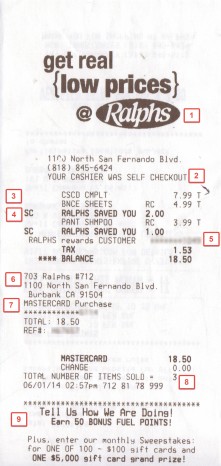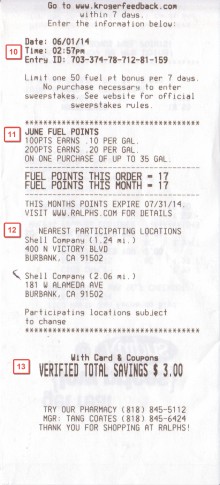we’re discussing big-data collection as prompted by a recently released federal trade commission report (see part 1 of this series), and i said i would use myself as an illustration. so, below is a receipt from a grocery store run i made last sunday.
grocery shopping is a home-task i did not volunteer for. delegated to me, i relish it with the same zeal as visiting the dentist. it’s nothing short of an expensive flash-mob experience and often feels like i’m in an episode of the walking dead. i affectionately refer to all my store visits in l.a. as the fool’s ballet. but i digress.
let’s look at my receipt from this trip so i can illustrate more than a few data nuggets.
- ralph’s is a so-cal staple and is currently owned by the kroger company. kroger posted $23.2 billion for fourth quarter 2013 sales. according to an ancient issue of cio magazine (august 1989), ralph’s pioneered the use of scanner data for merchandising analysis and, “…uses [it] extensively to […] optimize product shelf allocations and negotiate with suppliers.” in the time since this article was written, i assure you ralph’s does more than that.
- the checkout process is a point-of-sale system and the store knows precisely which one i used. from this a few things may be derived and added to my customer profile in ralph’s datastore: i may be an impatient shopper, depending how often i use self checkout, i don’t buy a lot of alcohol (california law prohibits alcohol purchases at self checkout).
- every item i buy is added to my profile along with all the other data here. not only that, but the combination of what i buy becomes a useful dataset: ‘seems this customer regularly buys shampoo, dryer sheets, and dishwasher soap at the same time!’
- a record of instant and cumulative total savings for each item is also tracked for a myriad of uses. these savings are not free, they are negotiated by or with the suppliers, arbitraged for further marketing co-ops and campaigns, and analyzed by advertising firms to score efficacy of media promotions.
- it’s all tied to my reward card!
- they know the location of the store down to the exact longitude and latitude. they also correlate this location to point-forecasts by either the national weather service or some private weather syndication. that collection of data is further analysed to drive a bunch of other analytics including staffing levels and scheduling for this store.
- it’s all tied to my credit card also!
- the precise date, time, location, checkout station, number of items, and probably the employee id logged into the overlord workstation responsible for all the self stations.
- the marketing incentive to get even more data from me!
- there has to be a way for the store to associate my survey result with my visit and my profile, hence the time/date/entry id — all three are required to enter the survey. it’s a simple survey with the basic questions and all associated with my profile. they asked me to enter my reward card number but in reality, they already have it from my receipt.
- the fuel points construct is becoming more common. it represents a business/marketing arrangement with the oil companies ’cause let’s face it, everyone likes saving at the pump. besides driving customers to stores as a brand (and developing further loyalty) it also represents significant data sharing arrangements.
- the benefit of knowing precise location data (longitude/latitude) is the ability to leverage GIS technologies (think of google maps) to save me time and steer me to the closest partner gas station.
- it’s big and bold, and it tells me how smart i am to shop here. again, brand loyalty.
- this isn’t on the receipt, and i didn’t scan an image for the post, but i also received a print-out coupon for a particular brand of cat food. i didn’t buy cat food on this trip but drawing on #5 above, the point-of-sale still spit a coupon out for me. why? because i had purchased cat food on previous trips and the system is smart enough to know me and my buying habits.
big whoop you say. big-data says i. this is only one receipt with 3 items. multiply that across hundreds of shoppers each hour and hundreds-of-thousands of stores and scores of items on each receipt.
this is part 2 of a multi-part series:
- part 1: go here
- part 2: this post
- part 3: what i look like to one of the big-data brokers, Acxiom
- part 4: discuss home energy management data and talk about data ownership
- part 5: how to curtail what’s known about you


